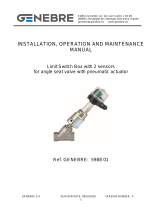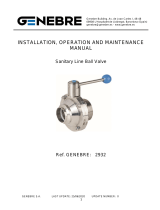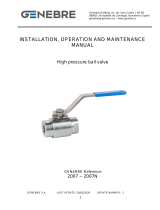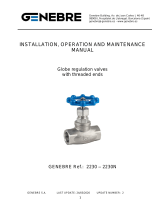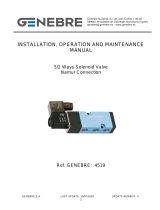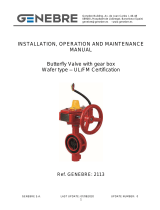
Genebre Building. Av. de Joan Carles I, 46-48
08908 L'Hospitalet de Llobregat. Barcelona (Spain)
[email protected] - www.genebre.es
GENEBRE S.A.
LAST UPDATE: 27/04/2020 UPDATE NUMBER: 1
1
INSTALLATION, OPERATION AND MAINTENANCE
MANUAL
Slanted Seat Valve with
Spring Return Pneumatic Actuator
GENEBRE reference: 5060 – 5060N

Genebre Building. Av. de Joan Carles I, 46-48
08908 L'Hospitalet de Llobregat. Barcelona (Spain)
[email protected] - www.genebre.es
GENEBRE S.A.
LAST UPDATE: 27/04/2020 UPDATE NUMBER: 1
2
Installation, Operation and Maintenance Instructions
1) Breakdown drawing. ........................................................................................................ 3
1.1) List of components: ................................................................................................... 3
2) Storage ............................................................................................................................. 4
3) Installation Instructions ................................................................................................... 5
3.1) Preparation .................................................................................................................. 5
3.3) Pneumatic Connection................................................................................................. 6
4) Operating Instructions ..................................................................................................... 7
4.1) Use .............................................................................................................................. 7
4.2) Special Conditions ....................................................................................................... 7
5) Maintenance Instructions ................................................................................................ 7
6) Repairing Instructions ..................................................................................................... 8
6.1) Dismantling .................................................................................................................. 8
6.2) Changing the Seat ....................................................................................................... 8
6.3) Changing the Gasket. .................................................................................................. 9
7) Hygiene and Safety: ....................................................................................................... 11

Genebre Building. Av. de Joan Carles I, 46-48
08908 L'Hospitalet de Llobregat. Barcelona (Spain)
[email protected] - www.genebre.es
GENEBRE S.A.
LAST UPDATE: 27/04/2020 UPDATE NUMBER: 1
3
1) Breakdown drawing.
1.1) List of components:
Nº
Name
Material
Surface
Treatment
Spare
Part Code
1*
Indicator Protector
Plastic
------
C5060
2
O’ring
NBR
------
------
3
Indicator
Nylon
------
------
4
Spring
Steel 65Mn
------
------
5
Nut
Aluminum
------
------
6
Actuator Body
Stainless Steel CF8 (304)
Shot blasting
------
7
Piston
Aluminum Alloy
------
------
8*
Piston Ring
FKM
------
R5060
9
O’ring
NBR
------
------
10
Washer
Stainless Steel AISI 304
------
------

Genebre Building. Av. de Joan Carles I, 46-48
08908 L'Hospitalet de Llobregat. Barcelona (Spain)
[email protected] - www.genebre.es
GENEBRE S.A.
LAST UPDATE: 27/04/2020 UPDATE NUMBER: 1
4
11
Bearing
Aluminum Alloy
------
------
12
Cover
Stainless Steel AISI 304
------
------
13*
O’ring
NBR
------
R5060
14
Check Ring
Stainless Steel AISI 304
------
------
15
Connection
Stainless Steel CF8M (316)
------
------
16*
Body Seal
PTFE
------
R5060
17
Stem
Stainless Steel AISI 316
------
------
18
Seat Support
Stainless Steel CF8M (316)
------
------
19*
Seat
PTFE
------
R5060
20
Nut
Stainless Steel AISI 316
------
------
21
Y - Ring
FKM
------
------
22
Washer
Stainless Steel AISI 304
------
------
23
Spring
Stainless Steel AISI 304
------
------
24
Washer
Stainless Steel AISI 304
------
------
25*
Stem Packing
PTFE + Carbon
------
E5060
26*
Stem Packing
PTFE
------
E5060
27*
Stem Packing
PTFE + Carbon
------
E5060
28
Valve Body
Stainless Steel 1.4408 (CF8M)
Shot blasting
------
* Available spare parts
2) Storage
During storage it is recommended to keep the packaging on to avoid bumps o excessive dirt
(the packaging should not be removed until the item is to be installed). Store in a dry clean
environment whenever possible.
Transportation and storage of these items must be done in its original packaging!
VISUAL INSPECTION
Check that the equipment has not been damaged during transportation, unloading and settling.
MECHANICAL VERIFICATION
Check that all moveable parts on the equipment, as well as the screws and other elements do their
job.
Should any error be detected during this reception procedure, contact GENEBRE
immediately so as to resolve whose responsibility it is and to set the equipment back to the
correct operating state!

Genebre Building. Av. de Joan Carles I, 46-48
08908 L'Hospitalet de Llobregat. Barcelona (Spain)
[email protected] - www.genebre.es
GENEBRE S.A.
LAST UPDATE: 27/04/2020 UPDATE NUMBER: 1
5
IMPORTANT NOTE:
Before installing and/or handling these pneumatic elements, READ CAREFULLY
these instructions and OBSERVE all the information contained therein. Should you
not understand any piece of information, please contact GENEBRE, S.A.
Responsibility for the safe use of this equipment belongs to the user, as
established in these instructions, as well as in the technical documentation specific to
the supplied equipment.
3) Installation Instructions
3.1) Preparation
Remove any remains of packaging from the valve.
There might be serious problems caused by valves installed in a dirty pipe.
Make sure the valve is free of dirt, welding particles, etc. before installation, since the valve
might suffer irreparable damage when the equipment is turned on → prepare a clean
working area.
Plan enough space for future maintenance operations.
3.2) Valve’s Installation
Make sure the pipe and the thread on the pipe are clean and are compatible (Thread type).
Apply the proper sealer on the pipe threads and screw the valve in carefully so as not to
tighten the conical threads in excess.
Do not use the valve actuator as a crowbar to thread the valve to the pipe.
To tighten the valve to the pipe, it is recommended to use a flat wrench or a monkey wrench,
applying strength only on the hexagonal area on the ends of the valve. It is recommended to
apply less than 30 Nm of strength.
The design of this type of valve has only one mounting position on the pipe,
which is indicated by an arrow engraved on the body of the valve to know which
direction the fluid must flow.

Genebre Building. Av. de Joan Carles I, 46-48
08908 L'Hospitalet de Llobregat. Barcelona (Spain)
[email protected] - www.genebre.es
GENEBRE S.A.
LAST UPDATE: 27/04/2020 UPDATE NUMBER: 1
6
It is recommended that, whenever possible, the valve is installed in a horizontal position with
the actuator facing up.
The valves should not stand burdens or efforts that should be carried by the pipe, which is
why it is recommended to have a good alignment and parallelism of the pipe.
We recommend the use of filters on the pipes to extend the lifespan of the valves.
3.3) Pneumatic Connection
The orifice for air feeding to the actuator is G 1/8”.
IMPORTANT: The supply air to use must be CLEAN and DRY.
Respect the minimum and maximum supply pressure (3 – 8 bar)
Supply Air
Entrance
Simple Effect Actuator (Spring Return)
Normal Closed (N.C.)

Genebre Building. Av. de Joan Carles I, 46-48
08908 L'Hospitalet de Llobregat. Barcelona (Spain)
[email protected] - www.genebre.es
GENEBRE S.A.
LAST UPDATE: 27/04/2020 UPDATE NUMBER: 1
7
4) Operating Instructions
4.1) Use
Before turning on the equipment, you must always take into account the Technical
Specifications and never exceed the values of the Feeding Limits of power and air.
Never touch the valve and/or pipes that are in contact with the surrounding fluid when the
process is active, since burns may occur.
• Operation medium: Dry or lubricated air, or inert non-corrosive gas.
• Air supply: 3 Bar (45 PSIG) to 8 Bar (120 PSIG) maximum.
• Working temperature: Standard –10°C to +60°C.
• Working environment: Suitable for internal use or outdoors applications.
4.2) Special Conditions
• The operation of the actuator in extreme temperature conditions exceeding the design limits
may damage internal and external parts, and it might be potentially hazardous for the
operating or maintenance personnel.
• The operation of the actuator in extreme pressure conditions exceeding the design limits
may cause a malfunction of the actuator and the spontaneous breakage of parts and,
therefore, might be potentially hazardous for the operating or maintenance personnel.
• Note: Do not dismantle the actuator under any circumstances when it is under supply
pressure.
5) Maintenance Instructions
This product does not require any kind of maintenance.
If any internal part has been damaged, contact Genebre, S.A. to assess the possibility of
repair.

Genebre Building. Av. de Joan Carles I, 46-48
08908 L'Hospitalet de Llobregat. Barcelona (Spain)
[email protected] - www.genebre.es
GENEBRE S.A.
LAST UPDATE: 27/04/2020 UPDATE NUMBER: 1
8
6) Repairing Instructions
Genebre, S.A. is not held responsible for the incorrect handling of the equipment or its parts.
Before repairing begins, disconnect the actuator pneumatically and electrically.
Use only original parts/spares or those recommended by GENEBRE, S.A.
6.1) Dismantling
Prepare a clean working area and the proper tools for mechanical tasks.
To perform the operation it is NOT necessary to remove the valve from the installation.
6.2) Changing the Seat
Loosen and remove the piece that joins to the valve (part 15) together with the actuator.
Be careful not to damage the surface of the valve.
Once the set has been removed, remove the nut that attaches to the seat (part 20) and
remove the seat from its enclosure. Place the new seat (part 19) and tighten up with the nut
(part 20)
ATENTTION – PLEASE READ CAREFULLY:
• BEFORE PERFORMING ANY MAINTENANCE OPERATION ON THE
ACTUATORS, IT IS ESSENTIAL THAT THEY ARE NOT UNDER PRESSURE AND
FREE OF ANY ACCESSORIES.
• FOR YOUR OWN SAFETY IT IS NECESSARY TO CHECK THAT THE UNIT IS IN
FAIL POSITION (EXTENDED AND UNCOMPRESSED SPRING) BEFORE
DISMANTLING A SIMPLE EFFECT ACTUATOR (SPRING RETURN).
Before removing the valve from the pipe for cleaning or substitution, make sure
the line has been closed and depressurized, since the wrong handling might
cause a serious accident as well as serious damage to the equipment

Genebre Building. Av. de Joan Carles I, 46-48
08908 L'Hospitalet de Llobregat. Barcelona (Spain)
[email protected] - www.genebre.es
GENEBRE S.A.
LAST UPDATE: 27/04/2020 UPDATE NUMBER: 1
9
Clean the seat area of the body of the valve before replacing the actuator set and verifying its
state. Should this area be damaged by the excessive use of the valve or by the effect of the
fluid that flows through the pipe, the body should be completely replaced.
Next, remove the gasket from the body (part.16) and replace it.
Reassembling:
Screw in the whole actuator set with the piece that attaches it to the valve. If possible,
perform this operation feeding air to the actuator to avoid friction between the seat and the
base of the body when screwing in the whole set, since the configuration of the valve is N.C
(normal closed).
Before turning on the installation, check the proper operation of the equipment with a dry run
(no fluid).
6.3) Changing the Gasket.
The piece that joins the valve and the actuator (part 15) has a hole on the side that would
indicate whether there is a leak through the shaft gasket. Should a fluid leak through this hole
be detected, the valve gasket set (part 25,29 and 31) should be replaced immediately.
Loosen and remove the piece that joins to the valve (part 15) together with the actuator.
Be careful not to damage the surface of the valve.
Since it is necessary to dismantle the actuator to change the shaft gasket, it is
recommended to thoroughly review all the internal parts and, should any wear on the
parts be detected, proceed to replace them too.
The dismantling of the actuator must be performed with extreme care, since
removing the seeger ring might eject the piston and might cause a serious
accident as well as serious damage to the equipment

Genebre Building. Av. de Joan Carles I, 46-48
08908 L'Hospitalet de Llobregat. Barcelona (Spain)
[email protected] - www.genebre.es
GENEBRE S.A.
LAST UPDATE: 27/04/2020 UPDATE NUMBER: 1
10
With the help of a small press or a bench screw, apply some pressure between the planes
shown in the following figure to slightly compress the spring and then be able to remove the
seeger ring (part 14) that holds the piston. Slowly loosen the pressure between these two
planes until it is completely released from the pressure of the spring.
Then remove the whole set from inside the body of the actuator (part 6).
Unscrew the nut that holds the seat (part 20) and also remove the seat assembly with the
piece where it is enclosed (part 18 and 19), push the shaft upwards and the whole set made
up of the shaft (part 17), the piston (part 7), the nut (part 5) and the indicator (part 3) will
come off.
Holding with a wrench from the hexagonal part of the piece that joins to the valve (part 15),
unscrew the lid (part 12 base of the actuator or lid).
Remove the spring (part 23) and with the help of a sharp object remove the set made up of
the gasket (part 25, 29 and 31) and the washer (part 24).
Clean all parts of the set before proceeding to reassemble it with the new parts.
Reassembling
A.- When it is not necessary to repair the actuator, proceed as follows:
Place the new gasket set (part 25, 29 and 31) as shown in the following figure, inside the
piece that joins the valve and the actuator (part 15), using some sort of lubricant to help
perform the task:

Genebre Building. Av. de Joan Carles I, 46-48
08908 L'Hospitalet de Llobregat. Barcelona (Spain)
[email protected] - www.genebre.es
GENEBRE S.A.
LAST UPDATE: 27/04/2020 UPDATE NUMBER: 1
11
Place the washer on top of the gasket (part 24) and then place the spring (part 23). Screw
the whole set to the lid or base of the actuator (part 12), and then insert the gasket and piston
set through the top.
Place the seat assembly (part 18 and 19) on the end of the gasket and fix it with the nut (part
20).
Verify the presence of the spring (part 4) inside the body of the actuator (part 6) and insert
the whole set. It is important to use some sort of lubricant to make the sliding easier.
Once more, with the help of a small press or a bench screw, apply some pressure between
the planes shown in the following figure to slightly compress the spring and then be able to
place the seeger ring (part 14) which will hold the lid or base of the actuator (part 12). Slowly
loosen the pressure between these two planes until you can make sure the seeger is
properly placed.
Attach the whole assembly to the body of the valve (part 30) as explained in section 6.2
(Reassembling)
B.- If we want to perform repairs on the actuator
Before proceeding to the assembly, you should check the state of internal parts 8 and 13 for
instance, and if necessary, replace them. Then, continue the assembly as instructed in the
previous item.
7) Hygiene and Safety:
When handling any kind of element, the appropriate safety measures should be taken, and it
is recommended to use personal protection elements:
1) Use eye protection.
2) Use proper gloves and work clothes.
3) Use protective footwear.
4) Use a helmet.
5) Be sure there is running water available.
/
